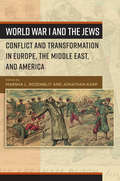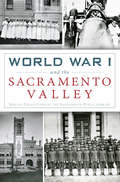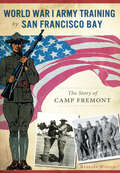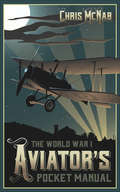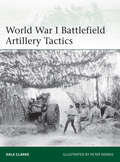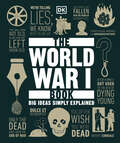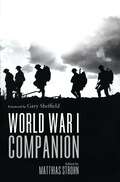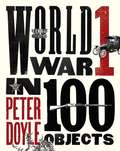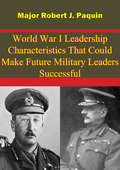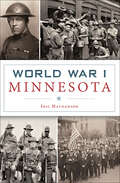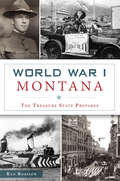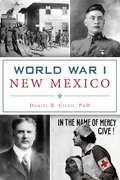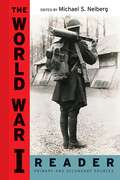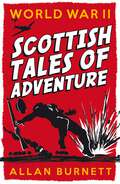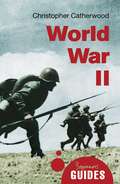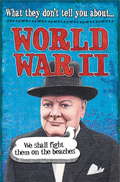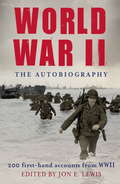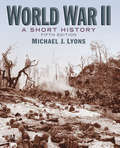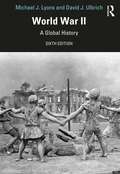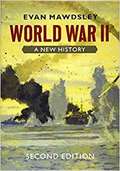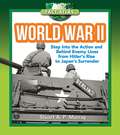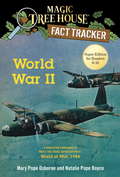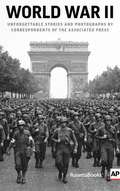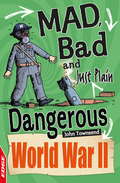- Table View
- List View
World War I and the Jews: Conflict and Transformation in Europe, the Middle East, and America
by Marsha L. Rozenblit Jonathan KarpWorld War I utterly transformed the lives of Jews around the world: it allowed them to display their patriotism, to dispel antisemitic myths about Jewish cowardice, and to fight for Jewish rights. Yet Jews also suffered as refugees and deportees, at times catastrophically. And in the aftermath of the war, the replacement of the Habsburg Monarchy and the Russian and Ottoman Empires with a system of nation-states confronted Jews with a new set of challenges. This book provides a fascinating survey of the ways in which Jewish communities participated in and were changed by the Great War, focusing on the dramatic circumstances they faced in Europe, North America, and the Middle East during and after the conflict.
World War I and the Sacramento Valley (Military)
by Special Collections of the Sacramento Public LibraryWhen the First World War thrust the United States into a dire global conflict, the Sacramento Valley was quick to mobilize. Many of America's first air units for combat were trained at Mather Field, while local farms filled some of the largest food supply orders for the Allies. Many women eschewed tradition and joined the industrial workforce at Liberty Iron Works, Southern Pacific Railroad and more. Though many banded together, the region's homefront was not without tension. Gripped by xenophobia, groups like the Liberty League formed local chapters to hunt spies, and local police forced displays of patriotism from suspected German sympathizers. With exclusive content from the Sacramento Public Library's Special Collections, librarians Amanda DeWilde and James Scott reveal the struggles and triumphs of the Sacramento region during the First World War.
World War I Army Training by San Francisco Bay: The Story of Camp Fremont (Military)
by Barbara WilcoxIn 1917, Stanford University leased a portion of its land to allow the creation of Camp Fremont, headquartered in present-day Menlo Park. That brought the war into the Bay Area's backyard. Soldiers received a welcome reception, and locals embraced the potential economic opportunities. However, the military presence also revealed the conflict Americans felt over the war. Residents threatened conscientious objectors within their community, while the government mollified fears of the vice that often followed troops in training. Armistice came earlier than expected, and many soldiers trained for combat they never saw. But all contributed to the growth and change that arrived with the modern era. Author Barbara Wilcox tells Camp Fremont's story of adaptability, bravery and extraordinary accomplishment during the Great War.
The World War I Aviator's Pocket Manual (The Pocket Manual Series)
by Chris McNabHow the first military pilots learned to fly—and fight: guidance from Great War training manuals. Aviation was still in its infancy when World War I broke out—and newly formed air forces produced manuals to help pioneers heading for the skies as they took warfare into a new dimension with reconnaissance missions, primitive bombing attempts, and attacks on enemy aircraft. Pulling together information from British manuals such as A Few Hints for the Flying Officer and Practical Flying, as well as American, German, and French training guides, this book shows the type of information the pilots were given, such as: · The basics of how to care for, start, and fly an aircraft · Tactics and strategy in the air · Identifying whether vehicles below were friend or foe · Interacting with mechanics · Coordinating with army or naval forces, and more This fascinating time capsule opens up the world of the Great War aviator and includes introductions to the manuals by Chris McNab, setting them in context and providing background.
World War I Battlefield Artillery Tactics
by Dale ClarkeFrom the beginning of 'trench warfare' in winter 1914/15, artillery became the absolutely dominant arm in all the major armies for the rest of World War I, to a degree never seen before or since. The numbers and capabilities of the guns and ammunition available governed all the generals' battle plans; and the ways in which they were employed, and either succeeded or failed, decided the outcome of battles. The majority of the millions of casualties suffered during the war fell victim to artillery fire.The artillery war fell into three distinct phases along a four-year learning curve (with the necessary equipment and training for the second and third phases always lagging behind the tactical needs). The war began with mostly light, mobile artillery equipped and trained to support fast-moving infantry and cavalry by direct fire, mostly with air-bursting shrapnel shells.The entirely unexpected end of the first campaigns of manoeuvre as the armies bogged down in static trench warfare found both sides ill equipped and ill trained for what was in essence siege warfare on an industrial scale. This demanded more and heavier guns and high-explosive shells, and more complex skills for indirect fire - observation on the ground and in the air, locating targets (including enemy artillery), dropping the right kind of shells on them, the communications needed for co-ordinating the work of hugely increased numbers of guns, and getting many millions of shells up to them for week-long bombardments. These seldom worked as anticipated (classically, by failing to 'cut the wire' or to penetrate deep bunkers); so innovative officers on both sides worked to devise new tactics, with more versatile mixes of ammunition (e.g. gas shells, smoke shells, star shells and so on) and more imaginative ways of using them, such as box barrages and creeping barrages.Finally, in early 1918, the static slogging broke down into a renewed phase of manoeuvre warfare, made possible by sophisticated co-operation between artillery and infantry, plus the newly important air and mechanised forces. The lessons that were finally learned shaped the use of artillery worldwide for the rest of the 20th century.Fully illustrated with period photographs and specially drawn colour artwork and drawing upon the latest research, this engaging study explains the rapid development of artillery tactics and techniques during the conflict in which artillery played a pre-eminent role - World War I.
The World War I Book (DK Big Ideas)
by DKDiscover the key battles, tactics, technologies, and turning points of the First World War - the epic conflict that was supposed to be "the war to end all wars."Combining authoritative, exciting text and bold images, The World War I Book explores the historical background of the war, its causes, all of the key events across the major theatres of conflict, and its aftermath.Using the original, graphic-led approach of the series, entries profile more than 90 of the key events during and surrounding the conflict - from the growing tensions between Europe's major powers to the assassination of Archduke Franz Ferdinand, the German invasion of Belgium, the endless slaughter in the trenches, the American entry into the war, the Russian Revolution, the Armistice, and the creation of the League of Nations.In this book, you can explore the following: -Key milestones of the First World War – exploring the technologies, tactics, and turning points.-Main theatres of the conflict and the experience of war – from civilian life to the horrors of gas attacks.-Bold imagery and clear text with insightful and inspiring quotes from military leaders and historiansOffering a uniquely compelling, accessible, and immediate history of the war, The World War I Book shows how certain key battles, individual leaders, political and economic forces, and technological advances influenced the course of the conflict and the following decades. This book is part of the Big Ideas Simply Explained series, with other titles including The Art Book, The Architecture Book, and The Astronomy Book.
World War I Companion
by Mathias Strohn2014 sees the centenary of the start of World War I, the Great War - the war to end all wars. This four-year conflict saw the major powers of the world commit their forces on an unparalleled scale, principally in the trenches of the Western Front, but also throughout the world from the colonies of Africa to the Chinese city of Tsingtao.This was a period of intense development in military technology, technique, and innovation as the belligerent powers sought to break the deadlock. The rise of airpower, coronation of artillery, and development of the tank as a means of restoring mobility to the battlefield all came about in this period and have had a lasting influence through to the present day.This study consists of separate articles by 13 respected academics focussing on different aspects of the Great War, ranging from the war at sea, through the Gallipoli campaign to the final offensives of 1918 to give a wide-ranging companion to this truly global conflict.
World War I for Kids: A History with 21 Activities
by R. Kent RasmussenAn educational and interactive children's guide to the Great War In time for the 2014 centennial of the start of the Great War, this activity book provides an intriguing and comprehensive look at World War I, which involved all of the world's superpowers during a time of great technological and societal change. Emphasizing connections among events as well as the war's influence on later historical developments, it leads young readers to fully understand the most important aspects of the war, including how the war came about, how changing military technology caused the western front to bog down into a long stalemate, how the war fostered an era of rapid technological advances, and how the entry of the United States helped end the war. The book explores topics of particular interest to kids, such as turn-of-the-20th-century weaponry, air and naval warfare, and the important roles animals played in the war. Relevant crosscurricular activities expand on concepts introduced and illuminate the era of the early 1900s, including making a periscope, teaching a dog to carry messages, making a parachute, learning a popular World War I song, and more.
World War I in 100 Objects
by Peter DoyleA dynamic social history commemorating the 100th anniversary of the start of World War I General readers and history buffs alike have made bestsellers of books like A History of the World in 100 Objects. In that tradition, this handsome commemorative volume gives a unique perspective on one of the most pivotal and volatile events of modern history. In World War I in 100 Objects, military historian Peter Doyle shares a fascinating collection of items, from patriotic badges worn by British citizens to field equipment developed by the United States. Beautifully photographed, each item is accompanied by the unique story it tells about the war, its strategy, its innovations, and the people who fought it.
World War I Leadership Characteristics That Could Make Future Military Leaders Successful
by Major Robert J. PaquinThis monograph analyzes the leadership characteristics that suggest a rapid acceptance of changing conditions in warfare among senior leaders and which leadership characteristics tend to suggest a more conservative approach. This conservative approach fails to recognize and adapt to the new emerging conditions. This research studied two World War I British leaders, General Sir Ivor Maxse and General Sir Hubert Gough, and compared and contrasted their leadership characteristics. From this, the research identified the most significant leadership characteristics that allowed these leaders to successfully adapt quickly in a time of transition.The criteria for analysis was based on four leadership characteristics as defined in FM 22-100, Army Leadership: Revised Final Draft, dated June 1998. The four leadership characteristics used as evaluation criteria were personal courage, initiative, tactical skill, and learning.A comparison of the role of the two World War I leaders yields the conclusion that certain leadership characteristics allowed them to adapt more easily in an evolving environment and facilitated successful battlefield leadership. These characteristics were moral courage, initiative, tactical skill and the application of knowledge through effective, continual learning.The monograph provides valuable insights into what leadership characteristics will allow current and future leaders to be successful, and unsuccessful, during a military transitional period. Our leaders must be creative, intuitive, dynamic, and able to make contemplated decisions, and have the courage and determination to act on them. The requirement for developing those leaders is an important one for the United States and a demanding one for the U.S. Army. An understanding of these leadership characteristics and the reasons that they facilitate successful battlefield leadership can provide an intellectual foundation beneficial to the Army as it prepares for future warfare.
World War I Minnesota (Military Ser.)
by Iric NathansonWhen the United States made a formal declaration of war on April 6, 1917, Minnesotans answered the call to arms. Duluth, with its strategic location at the head of the Great Lakes, emerged as a major shipbuilding center. Over forty thousand men registered for the draft in Minneapolis alone. Yet many members of the state's large German American population struggled with divided loyalties. A xenophobic fervor swept through the state at an alarming rate, forcing the government to establish a Commission on Public Safety to stifle wartime dissent. With more than fifty period photos and illustrations, author Iric Nathanson brings to life the daily struggles and triumphs of Minnesotans in the Great War.
World War I Montana: The Treasure State Prepares (Military)
by Ken RobisonMontana's cowboys, miners, foresters, farmers and nurses entered World War I in April 1917 under the battle cry that would resonate on the battlefields in France--"Powder River, Let 'Er Buck!" Montana men served in a greater percentage per capita than any other state. Hundreds responded to the call, including local women and minorities, from the nation's first congresswoman, Jeannette Rankin, to young women serving as combat nurses on the front lines. Additionally, the state provided vital supplies of copper and wheat. Learn what role celebrities like "cowboy artist" Charlie Russell played in the war and how Montanans mobilized, trained and deployed. Acclaimed historian Ken Robison uncovers new and neglected stories of the Treasure State's contributions to the Great War.
World War I New Mexico (Military)
by Daniel R.In 1917, five years after New Mexico received its statehood, the United States entered World War I. With border tensions festering between Mexico and the United States, Germany attempted unsuccessfully to secure Mexico’s allegiance with its Zimmermann Telegram. More than sixteen thousand New Mexicans joined the military, while civilians supported from the home front. Groups like the Knights of Columbus, YMCA and the Salvation Army, as well as Governor W.E. Lindsey’s New Mexico Council of Defense, raised military funding. Author Daniel R. Cillis recounts the Land of Enchantment’s influence on World War I from its beginning through to the 1918 Armistice.
The World War I Reader
by Michael S. NeibergAlmost 100 years after the Treaty of Versailles was signed, World War I continues to be badly understood and greatly oversimplified. Its enormous impact on the world in terms of international diplomacy and politics, and the ways in which future military engagements would evolve, be fought, and ultimately get resolved have been ignored. With this reader of primary and secondary documents, edited and compiled by Michael S. Neiberg, students, scholars, and war buffs can gain an extensive yet accessible understanding of this conflict. Neiberg introduces the basic problems in the history of World War I, shares the words and experiences of the participants themselves, and, finally, presents some of the most innovative and dynamic current scholarship on the war. Neiberg, a leading historian of World War I, has selected a wide array of primary documents, ranging from government papers to personal diaries, demonstrating the war's devastating effect on all who experienced it, whether President Woodrow Wilson, an English doughboy in the trenches, or a housewife in Germany. In addition to this material, each chapter in The World War I Reader contains a selection of articles and book chapters written by major scholars of World War I, giving readers perspectives on the war that are both historical and contemporary. Chapters are arranged chronologically and by theme, and address causes, the experiences of soldiers and their leaders, battlefield strategies and conditions, home front issues, diplomacy, and peacemaking. A time-line, maps, suggestions for further reading, and a substantive introduction by Neiberg that lays out the historiography of World War I round out the book.
World War II: Scottish Tales Of Adventure
by Allan BurnettThe Second World War from a Scottish point of view—stories about men and women, allies and enemies to captivate and intrigue young readers. Acclaimed children&’s author Allan Burnett turns his attention to the Second World War in a book of explosively exciting and emotionally charged tales of bravery and adventure. Featuring the true exploits of soldiers, spies, pilots, sailors and many others, these stories, all based on interviews with these heroes themselves or their descendants, offer a unique, personal insight into the Second World War that no conventional history book can ever hope to match. &“With accounts of life on a variety of fronts this is a valuable introduction to life during the Second World War for younger readers . . . In a slim volume he manages to pack a lot in, allowing the reader a taste of a wide range of views and experiences, and never succumbing to a simplistic goodies versus baddies take on things . . . the heart of the stories themselves is surely universal, reminding us that war is a multi-faceted business affecting different people in all sorts of different ways.&” —Daily Record
World War II: A Beginner's Guide (Beginner's Guides)
by Christopher CatherwoodWith over sixty million casualties, World War II was the bloodiest conflict in history. In this incisive introduction, esteemed academic Christopher Catherwood covers all the key battles and campaigns, while also giving the larger story behind them, putting familiar events into the perspective of the war at large. He explores the huge impact of the preceding Sino-Japanese War on World War II itself; the relative unimportance of the British conflict in Africa; the near moral-equivalence of the Red Army and the Nazis; and the impact of the Hiroshima bombing. Full of text-boxes revealing key details about British intelligence, weaponry, and the social milieu to the conflict, there is no better brief introduction to this landmark event.
World War II (What They Don't Tell You About #31)
by Robert FowkeDid you know that Adolf Hilter wasn't, in fact, German?The Second World War brought horror and heartache to millions of people all over the globe, and it turned everyday living upside down too. Any history book will give you the boring facts THEY think you should know, but only this one will tell you what life during World War II was REALLY like ...
World War II: The Autobiography
by Jon E. LewisHow will the Second World War be remembered? Not as a series of strategic battles but as a dramatic turning point in world history, recorded through the personal accounts, diaries, and speeches of those that were there. World War Two: the Autobiography places centre stage the individual accounts of over 200 people who saw events unfolding before their eyes: from the first stirrings of Nazi aggression, to the phoney war and the Blitzkrieg; from the frozen wastes of the Eastern Front to life under the threat of the Blitz in London. This autobiography offers a panoramic view of the conflict and with entries from all the major figures of the war, including Churchill, Field Marshal Montgomery, Hitler, Stalin and Rommel, as well as accounts from the men and women on the front line, the home front and those unfortunate to be prisoners of war, from all sides of the conflict.
World War II: A Short History
by Michael J. LyonsHighly regarded for its concise clarification of the complexities of World War II, this book illuminates the origins, course, and long-range effects of the war. It provides a balanced account that analyzes both the European and Pacific theaters of operations and the connections between them. The Fifth Edition incorporates new material based on the latest scholarship, offering updated conclusions on key topics and expanded coverage throughout.
World War II: A Global History
by Michael J. Lyons David J. UlbrichFully revised and restructured, the sixth edition of World War II: A Global History offers students a concise and yet thorough textbook that examines history’s bloodiest conflict. The chapters alternate between chronological chapters on Europe and Asia-Pacific and thematic chapters on innovations, home fronts, brutal regimes, and logistics. This textbook includes the following features: A lively narrative of facts, events, people, and ideas that incorporates thoughtful analysis New material and restructured content on global factors that affected the causes, conduct, and consequences of World War II Balanced pace that does not bog readers down in too many details yet gives them sufficient depth and breadth for context Chapters, sections, and sidebars arranged in ways that can complement lectures and assignments Fifty new photographs that illustrate the human condition and weaponry during World War II. Global in focus, by blending both geographic and thematic chapters to ensure readers gain a comprehensive understanding of impact of the war worldwide, this is the perfect volume for all students of the biggest global conflict of the twentieth century.
World War II: A New History
by Evan MawdsleyThis is a revised and updated edition of Evan Mawdsley's acclaimed global history of World War II. Beginning with the outbreak of the Sino-Japanese War, Evan Mawdsley shows how the war's origins lay in a conflict between the old international order and the new and traces its globalisation as it swept through Asia, Europe and the Middle East. <P><P>The primary focus is on the war's military and strategic history, though also examines the political, economic, ideological and cultural factors which influenced the course of events. The war's consequences are examined too, not only in terms of the defeat of the Axis but also of the break-up of colonial empires and the beginning of the Cold War. Accessibly written and well-illustrated with maps and photographs, the book also includes insightful short studies of the figures, events and battles that shaped the war, as well as fully updated guides to further reading.
World War II: Step into the Action and behind Enemy Lines from Hitler's Rise to Japan's Surrender (Fact Atlas Series #No. 6)
by Stuart MurrayThe Fact Atlas series offers an age-appropriate overview of the historic and world-changing events of World War II, covering everything from the rise of Hitler and Nazism to the tragedy of the Holocaust and its long-lasting effects. Readers will be introduced to key players--political and military leaders like Winston Churchill and Franklin Roosevelt as well as Joseph Stalin, Benito Mussolini, and many more. Explore the ideas of democracy versus totalitarianism and international relations as a whole during the 1930s. Learn more about the different countries that became involved in the Second World War, with a focus on most of Europe, the United States, and Japan. Lesser-known facts about the involvement of countries such as China, Libya, Ethiopia, and New Zealand make it very clear that the war touched all corners of our world. Accompanied by photos and maps to outline specific events, this book offers a careful breakdown of how the war played out globally. Battles and campaigns are explained and examined, and young readers will be able to follow the war from beginning to end, analyzing causes and effects of each important event. World War II gives young readers the opportunity to grasp the weight and magnitude of one of the very worst wars the world has seen.
World War II: A Nonfiction Companion to Magic Tree House Super Edition #1: World at War, 1944 (Magic Tree House (R) Fact Tracker #36)
by Mary Pope Osborne Natalie Pope Boyce Carlo MolinariIn the next Magic Tree House® Fact Tracker, track the facts about World War II—with Jack and Annie! When Jack and Annie came back from their adventure in Magic Tree House Super Edition #1: World at War, 1944, they had lots of questions. How did World War II begin? Why were so many innocent people killed? What was D-Day? Find out the answers to these questions and more as Jack and Annie learn all about one of the darkest hours of history. Filled with up-to-date information, photographs, illustrations, and tidbits from Jack and Annie, the Magic Tree House Fact Trackers are the perfect way for kids to find out more about the topics they discover in their favorite Magic Tree House adventures. And teachers can use the Fact Trackers alongside their Magic Tree House fiction companions to meet Common Core text pairing needs. Have more fun with Jack and Annie on the Magic Tree House website at MagicTreeHouse.com! Did you know there’s a Magic Tree House book for every reader? Find the perfect book for you: Classic: Adventures with Jack and Annie, perfect for readers who are just starting to read chapter books. F&P Level M. Merlin Missions: More challenging adventures for the experienced Magic Tree House® reader. F&P Level N. Super Edition: A longer and more dangerous adventure with Jack and Annie. F&P Level P. Fact Trackers: Non-fiction companions to your favorite Magic Tree House® adventures
World War II: Unforgettable Stories and Photos by Correspondents of The Associated Press
by The Associated PressPowerful, visceral, and essential to preserving and understanding our past, the work of Associated Press photographers and journalists lives on through the pages of World War II.Never before in history had the day-to-day struggles and victories of war—from the home front to the front lines—been chronicled in such graphic and unflagging detail as during the Second World War. Nearly 200 photographers and reporters of Associated Press volunteered to cover the war across the globe from 1939 through 1945. The heroic achievements of these reporters and photographers—some of whom gave their lives—are remembered through the stunning photographs and moving firsthand reports of World War II: Unforgettable Stories and Photographs by Correspondents of The Associated Press.World War II commemorates the experiences of the individuals who brought the war into the homes of millions of Americans. Originally published in 1945 as Reporting to Remember: Unforgettable Stories and Pictures of the War by Associated Press Correspondents, this updated anniversary edition includes a new interview with former AP World War II correspondent George Bria, as well as a new Foreword by current AP Vice President for International News John Daniszewski.
World War II (EDGE: Mad, Bad and Just Plain Dangerous #4)
by John TownsendTime to take a sideways look at the bizarre and outrageous from throughout history - and it's all TRUE!Which mad weapons were actually used during combat? Who was the bad guy in charge of the Nazi German air force? Which dangerous mission helped to capture the Nazis' new tank?Find out the answers to these questions inside, along with lots of facts, quizzes, and other bonkers stuff as you take a bumpy journey into the darkest crannies of World War II history with Mad, Bad and Just Plain Dangerous!
